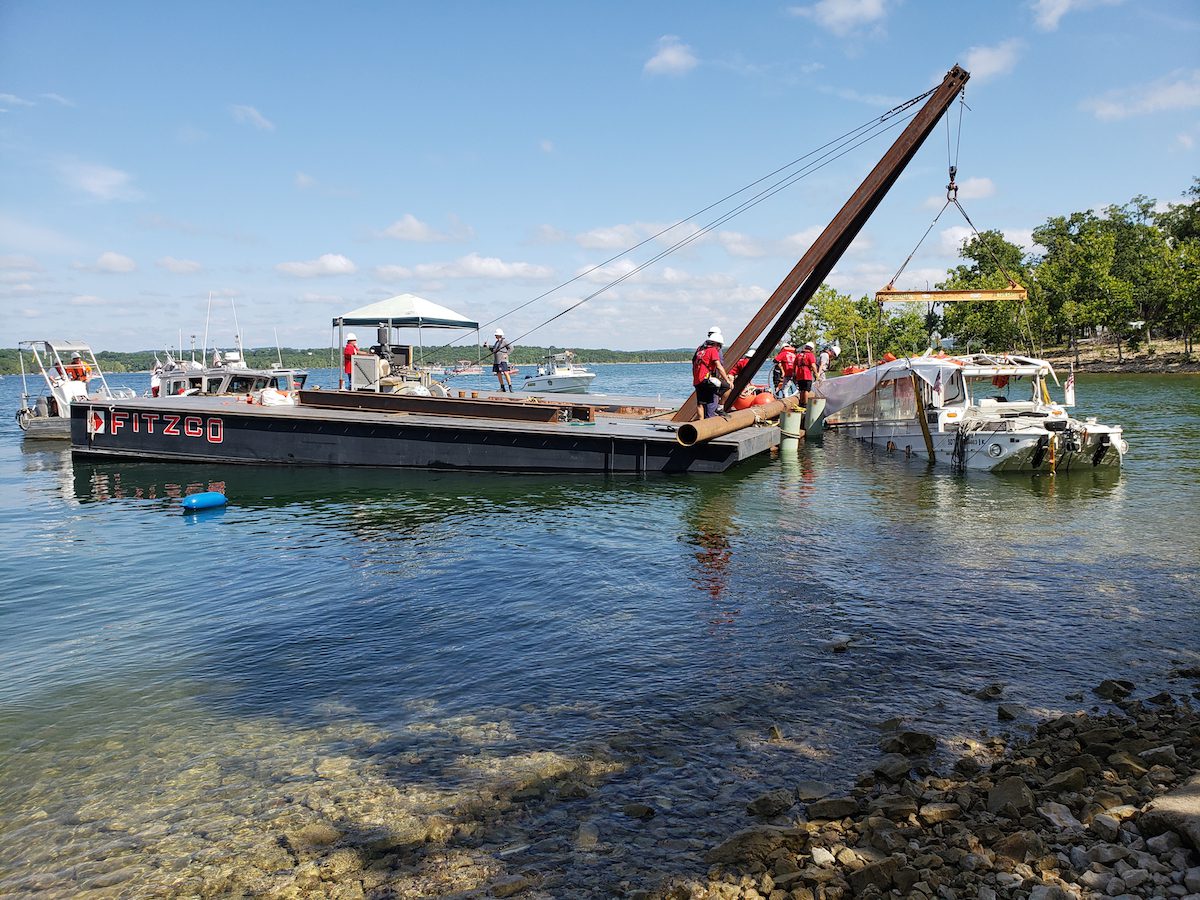The Coast Guard oversees the removal of Stretch Duck 7 from Table Rock Lake in Branson, Missouri, July 23, 2018. U.S. Coast Guard Photo
The National Transportation Safety Board announced Friday that it has completed its initial review of video recovered from the DUKW “Stretch Boat 7” that sank July 19 near Branson, Missouri, revealing a preliminary timeline of events leading up to the sinking.
The “Ride The Ducks” amphibious vehicle had 29 passengers and two crewmembers aboard for a tour when it capsized and sank on Table Rock Lake during severe weather. One crewmember and 16 passengers died in the accident.
Recordings from the Stretch Boat 7’s final moments were included on an SD card and a removable hard drive from the boat’s digital video recorder camera system that were recovered by divers before the duck boat was salvaged and immediately turned over to NTSB investigators.
In total, the boat’s cameras recorded five channels of video: four outward facing and one inward facing. Audio was also recorded.
All media recovered was sent to a NTSB laboratory in Washington for analysis.
The NTSB’s initial review of the recorder, posted below, provides information which is preliminary and will be supplemented or corrected during the investigation.
The times presented below are as-recorded by the DVR and have not yet been validated against local time. The information also does not contain analysis and, as such, no conclusions regarding the cause of the accident should be made from this preliminary information below:
The NTSB’s initial review findings from the video are below:
- The audio quality varies widely throughout the recording, affecting the intelligibility of what is spoken.
- About 18:27:08. The captain and driver boarded the previously empty vehicle. The driver sat in the driver’s seat and the captain sat in the side-facing seat to the right of the driver. (The captain operates the duck on water and the driver operates duck on the road.)
- About 18:28:00. The crew was told to take the water portion of the tour first, by an individual who briefly stepped onto the rear of the vehicle.
- About 18:29:13. As the passengers were loading, the captain made a verbal reference to looking at the weather radar prior to the trip.
- About 18:33:10. The driver stated a passenger count of 29 and shortly after, the vehicle departed the terminal facility. The captain narrated the tour while the vehicle was in motion.
- Starting about 18:50. In the vicinity of the boat ramp, the captain began a safety briefing regarding the water portion of the tour. The briefing included the location of emergency exits as well as the location of the life jackets. The captain then demonstrated the use of a life jacket and pointed out the location of the life rings. The captain moved into the driver’s seat and the driver moved into the seat directly behind.
- About 18:55:20. The captain announced to the passengers that they would be entering the water. The boat entered the water. The water appeared calm at this time.
- Between about 18:56:22 and 19:00:38. The captain allowed four different children to sit in the driver’s seat, while he observed and assisted.
- About 19:00:25. Whitecaps rapidly appeared on the water and winds increased.
- About 19:00:42. The captain returned to the driver’s seat. The driver lowered both the port and starboard clear plastic side curtains.
- About 19:01:01. The captain made a comment about the storm.
- About 19:03:15. The captain made a handheld radio call, the content of which is currently unintelligible.
- About 19:04:15. An electronic tone associated with the bilge alarm activated.
- About 19:05:21. The captain reached downward with his right hand and the bilge alarm ceases.
- About 19:05:40. The captain made a handheld radio call, the content of which is currently unintelligible.
- In the final minutes of the recording. Water occasionally splashes inside the vehicle’s passenger compartment. (The low frame rate and relatively low resolution make it very difficult to be more precise in the preliminary review.)
- About 19:07:26. An electronic tone associated with the bilge alarm activated.
- 19:08:27. The inward-facing recording ended, while the vehicle was still on the surface of the water.
Next, a NTSB recorder group consisting of technical experts from the NTSB and parties to the investigation will convene at NTSB headquarters to begin validating the recorded data and developing a detailed transcript of the sequence of events.
Additional agencies participating in the NTSB’s investigation of the accident are the U.S. Coast Guard, Missouri State Police Highway Patrol, Ride the Ducks, Branson and the National Weather Service.
Unlock Exclusive Insights Today!
Join the gCaptain Club for curated content, insider opinions, and vibrant community discussions.

 Join The Club
Join The Club







![A screengrab of a map showing an earthquake Mindanao, Philippines on Dec 2, 2023. (Image: US Geological Survey [USGS])](https://gcaptain.com/wp-content/uploads/2023/12/Screenshot-2023-12-02-at-10.45.17-AM-copy.png.webp)





